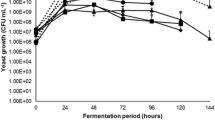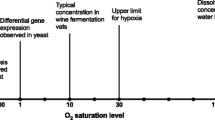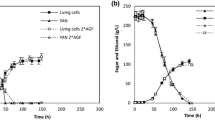Abstract
The growth and glucose uptake of single cultures of the wine-related yeasts Kluyveromyces thermotolerans, Torulaspora delbrueckii, and Saccharomyces cerevisiae were investigated. The yeasts had different specific glucose uptake rates (q s) that depended on the residual glucose concentration and the oxygen availability. In mixed cultures, the q s values of the yeasts were not subject to any interaction effects over a wide range of glucose concentrations. Our results strongly indicate that the relative glucose uptake abilities of both non-Saccharomyces yeasts, i.e. the q s(non-Saccharomyces)/q s(S. cerevisiae) ratios, regulated their abilities to compete for space in mixed cultures with S. cerevisiae, which, in turn, regulated their early deaths. This hypothesis enabled us to explain why K. thermotolerans was less able than T. delbrueckii to coexist with S. cerevisiae in mixed cultures. Furthermore, it enabled us to explain why oxygen increased the abilities of K. thermotolerans and T. delbrueckii to coexist with S. cerevisiae in the mixed cultures.





Similar content being viewed by others
References
Becker J-U, Betz A (1972) Membrane transport as controlling pacemaker of glycolysis in Saccharomyces carlsbergensis. Biochim Biophys Acta 274:584–597
Casey GP, Ingledew WM (1986) Ethanol tolerance in yeasts. Crit Rev Microbiol 13:219–280
D’Amore T, Panchal CJ, Russell I, Stewart GG (1990) A study of ethanol tolerance in yeast. Crit Rev Biotechnol 9:287–304
Fuge EK, Werner-Washburne M (1997) Stationary phase in the yeast Saccharomyces cerevisiae. In: Hohmann S, Mager WH (eds) Yeast stress responses. Springer, Berlin Heidelberg New York, pp 53–74
Hansen EH, Nissen P, Sommer P, Nielsen JC, Arneborg N (2001) The effect of oxygen on the survival of non-Saccharomyces yeasts during mixed culture fermentations of grape juice with Saccharomyces cerevisiae. J Appl Microbiol 91:541–547
Kilian SG, Deemeter A van, Kock JLF, Preez JC du (1991) Occurrence and taxonomic aspects of proton movements coupled to sugar transport in the yeast genus Kluyveromyces. Antonie Van Leeuwenhoek 59:199–206
Loureira-Dias MC (1988) Movements of protons coupled to glucose transport in yeasts. A comparative study of 248 yeast strains. Antonie Van Leeuwenhoek 54:331–343
Luyten K, Riou C, Blondin B (2002) The hexose transporters of Saccharomyces cerevisiae play different roles during enological fermentation. Yeast 19:713–726
Maier A, Völker B, Boles E, Fuhrmann GF (2002) Characterisation of glucose transport in Saccharomyces cerevisiae with plasma membrane vesicles (countertransport) and intact cells (initial uptake) with single Hxt1, Hxt2, Hxt3, Hxt4, Hxt6, Hxt7 or Gal2 transporters. FEMS Yeast Res 2:539–550
Mauricio JC, Guijo S, Ortega JM (1991) Relationship between phospholipid and sterol contents in Saccharomyces cerevisiae and Torulaspora delbrueckii and their fermentation activity in grape musts. Am J Enol Vitic 42:301–308
Nissen P, Arneborg N (2003) Characterization of early deaths of non-Saccharomyces yeasts in mixed cultures with Saccharomyces cerevisiae. Arch Microbiol 180:257–263
Nissen P, Nielsen D, Arneborg N (2003) Viable Saccharomyces cerevisiae cells at high concentrations cause early growth arrest of non-Saccharomyces yeasts in mixed cultures by a cell–cell contact mediated mechanism. Yeast 20:331–341
Özcan S, Johnston M (1995) Three different regulatory mechanisms enable yeast hexose transporter (HXT) genes to be induced by different levels of glucose. Mol Cell Biol 15:1564–1572
Press WH, Flannery SA, Teukolsky SA, Vetterling WT (1988) Numerical recipes of C. Cambridge University Press, Cambridge
Salmon JM (1989) Effect of sugar transport inactivation in Saccharomyces cerevisiae on sluggish and stuck enological fermentations. Appl Environ Microbiol 55:953–958
Salmon JM, Vincent O, Mauricio JC, Bely M, Barre P (1993) Sugar transport inhibition and apparent loss of activity in Saccharomyces cerevisiae as a major limiting factor of enological fermentations. Am J Enol Vitic 44:56–64
Truong-Meyer X-M, Streihaiano P, Riba J-P (1997) Thermal inactivation of two yeast strains in a strawberry product: experimental data and kinetic model. Chem Eng J 65:99–104
Uden N van (1967) Transport-limited fermentation and growth of Saccharomyces cerevisiae and its competitive inhibition. Arch Mikrobiol 58:155–168
Uden N van (1985) Ethanol toxicity and ethanol tolerance in yeasts. Annu Rep Ferment Proc 8:11–58
Visser W, Scheffers WA, Batenburg-van der Vegte WH, Dijken JP van (1990) Oxygen requirements of yeasts. Appl Environ Microbiol 56:3785–3792
Zwietering MH, Jongenburger I, Rombouts FM, Riet K van’t (1990) Modeling of the bacterial growth curve. Appl Environ Microbiol 56:1875–1881
Acknowledgement
This work was financed by The Royal Veterinary and Agricultural University, Frederiksberg, Denmark.
Author information
Authors and Affiliations
Corresponding author
Rights and permissions
About this article
Cite this article
Nissen, P., Nielsen, D. & Arneborg, N. The relative glucose uptake abilities of non-Saccharomyces yeasts play a role in their coexistence with Saccharomyces cerevisiae in mixed cultures. Appl Microbiol Biotechnol 64, 543–550 (2004). https://doi.org/10.1007/s00253-003-1487-0
Received:
Revised:
Accepted:
Published:
Issue Date:
DOI: https://doi.org/10.1007/s00253-003-1487-0




